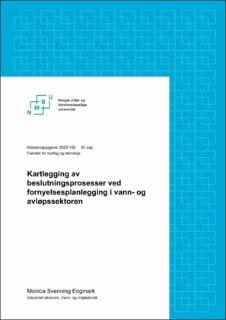| dc.contributor.advisor | Stevik, Tor Kristian | |
| dc.contributor.advisor | Skaar, Bjørn Solnes | |
| dc.contributor.author | Engmark, Monica Svenning | |
| dc.coverage.spatial | Norway | en_US |
| dc.date.accessioned | 2021-01-06T09:52:19Z | |
| dc.date.available | 2021-01-06T09:52:19Z | |
| dc.date.issued | 2020 | |
| dc.identifier.uri | https://hdl.handle.net/11250/2721658 | |
| dc.description.abstract | Norsk VA-sektor står i dag ovenfor store utfordringer knyttet til å opprettholde en fornuftig fornyelsestakt for vann- og avløpsnettet, samtidig som det er et betydelig vedlikeholdsetterslep. Tilstanden til norsk vannforsynings- og avløpsanlegg er i rapporten «Norges tilstand 2019» vurdert til at det må forventes ekstraordinært vedlikehold for å opprettholde drift. Ifølge rapporteringer fra KOSTRA kreves det en økning tilnærmet 70 % i forhold til dagens fornyelsestakt for å nå opp til den nødvendige fornyelsestakten beregnet av Norsk Vann. For å få realisert denne økningen må sektoren ta grep og tenke utenfor gamle vaner.
Oppgaven tar for seg planlegging og prosjektgjennomføring ved fornyelsesarbeid i et utvalg norske kommuner med ulik størrelse og geografisk tilhørighet. Gjennom dybdeintervjuer med informanter fra 16 norske kommuner opparbeides det datagrunnlag for å kartlegge hvordan beslutningsprosessene knyttet til fornyelsesplanlegging av offentlig ledningsnett foregår i dette utvalget. Ved å kartlegge dagens beslutningsprosesser dannes det grunnlag for å utarbeide tiltak for å øke fornyelsestakten.
Resultatene viser at kommunene har ulike tilnærminger til beslutningsprosessen, med en varierende grad av krav til dokumentasjon. Bare halvparten av utvalget benytter seg av standardiserte modeller i sitt arbeid med ledningsfornyelse. De resterende kommunene kjente likevel igjen sin prosess i eksempelmodeller som ble presentert for dem. Kommunenes vurdering av hva best praksis er har vist seg å være svært forskjellig. Det er en generell enighet i at det finnes forbedringspotensial i sektoren, likevel er alle kommunene fornøyd med måten de selv jobber på. Et viktig grep i arbeidet med å heve fornyelsestakten er derfor å heve kompetansenivået i norsk VA-sektor. Funnene i denne oppgaven viser at det bare er kommuner som benytter seg av en standardisert modell som når sine oppsatte mål for fornyelsestakt. Dette dokumenterer gevinster ved å følge en enhetlig prosjektmetodikk også i kommunal sektor.
Konklusjonen er at ved kartlegging av beslutningsprosesser knyttet til fornyelsesplanlegging av offentlig ledningsnett har det blitt avdekket et gap i kommunenes tilnærming til prosessen, og deres oppfatninger om hva beste praksis er. Det framkommer en tydelig sammenheng mellom benyttelse av en beslutningsmodell og måloppnåelse i arbeidet med ledningsfornyelse. Dette tilsier at det er fornuftig av kommunene å innføre en modell. | en_US |
| dc.description.abstract | The Norwegian water and wastewater sector is facing challenges in maintaining a reasonable rate of pipeline renewal of water and wastewater network, while simultaneously facing a considerable lag in maintenance. The current status of the Norwegian water supply- and wastewater-pipeline network has been evaluated in the report “State of the Nation 2019” which concluded that extraordinary maintenance to maintain operational function should be expected. According to KOSTRA reports, there is a need for an approximate increase of 70 % compared to present rate of renewal, to achieve the necessary renewal rate calculated by Norsk Vann. To make this increase in renewal rate a realization, the sector need to reevaluate present practices and think new.
The focus of this thesis is planning and project management of renewal work in a selected number of municipalities in Norway, with differences in area and geographical affiliations. Through in-depth interviews of informants from 16 Norwegian municipalities, a dataset is made to map how the decision-making process related to planning of pipeline-renewal in the public sector are done in my selection of municipalities. By mapping present decision processes, a foundation to develop methods to increase the rate of renewal is made.
The results from this thesis show that the municipalities have different approaches to the decision-making process, with a varying level of requirements to documentation. Only half of the selection use standardized models in their work with network renewal. Although, the rest of the municipalities did recognize their processes in examples of models presented to them. The municipalities assessment of what the best practice is, have shown to be with great differences. There is a general agreement in that there is a current need for improvement in the sector, nevertheless, all the municipalities from the assay in this thesis are satisfied with their own way of working. An important factor to improve the rate of renewal is therefore to increase the level of competence in the Norwegian water and wastewater sector. The results presented in this thesis do show that only the municipalities that follow standardized models actually achieve their goals of renewal rates, and therefore documents the benefits of following a uniform project methodology, also within the municipal sector.
The conclusion is that mapping of the decision-making processes related to planning of pipeline renewal in the municipalities reveal a gap in their approaches to the process, and their perception of what the best practice is. A clear context between the use of decision models and achieving set goals in the work of pipeline-renewal is present. This implies that it is reasonable for the municipalities to implement such models. | en_US |
| dc.language.iso | nob | en_US |
| dc.publisher | Norwegian University of Life Sciences, Ås | en_US |
| dc.rights | Attribution-NoDerivatives 4.0 Internasjonal | * |
| dc.rights.uri | http://creativecommons.org/licenses/by-nd/4.0/deed.no | * |
| dc.subject | Fornyelsesplanlegging | en_US |
| dc.subject | Vann | en_US |
| dc.subject | Beslutningsprosesser | en_US |
| dc.subject | Beslutningsmodeller | en_US |
| dc.title | Kartlegging av beslutningsprosesser ved fornyelsesplanlegging i vann- og avløpssektoren | en_US |
| dc.type | Master thesis | en_US |
| dc.description.version | submittedVersion | en_US |
| dc.subject.nsi | VDP::Teknologi: 500::Bygningsfag: 530::Konstruksjonsteknologi: 533 | en_US |
| dc.source.pagenumber | 89 | en_US |
| dc.description.localcode | M-IØ | en_US |

